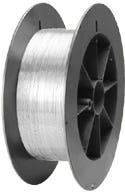Metal Fabricator Introduces ‘Green’ Oxide-Free Nitinol Wire
November 14, 2008
Originally Published MPMN November/December 2008
BREAKTHROUGHS
Metal Fabricator Introduces 'Green' Oxide-Free Nitinol Wire
|
NitiBrite nitinol wire is processed using an oxide-removal technique that produces a smooth, shiny surface without the use of acid-based solutions. |
Going green by way of reducing the output of hazardous waste and implementing sustainable practices is a challenge for many manufacturers. But for Johnson Matthey Medical, making a commitment to sustainability has proven to be worth the effort. The company’s attempts to reduce its environmental impact has inspired it to develop a nontoxic oxide removal process for nitinol wire.
Designed for the guidewire industry, NitiBrite wire is the result of a corporate initiative to reduce Johnson Matthey’s carbon emissions. The company aims to achieve zero waste and halve the key resources that it consumes per unit output by 2017—Johnson Matthey’s 200th anniversary. “What we’ve been doing internally is looking at things we do that generate hazardous waste,” says Joseph Kain, a nitinol technical specialist for Johnson Matthey.
This reevaluation of its processes led Johnson Matthey to find a more sustainable oxide-removal process. Like its competitors, Johnson Matthey employed an oxide-removal process that used toxic hydrofluoric acid solutions. However, in compliance with the company’s sustainability directive, the staff sought to create a more environmentally friendly process that achieved the same, if not better, results. The outcome of this effort was a one-step oxide-removal process for nitinol wire that eliminated the need for acid-based solutions.
In addition to the environmental benefits achieved by using the new oxide-removal technique, the process enabled the development of a better product to offer OEMs, according to Kain. “It’s a good feedstock for [OEMs’] process because it eliminates one step in their process,” Kain comments. “A lot of our end-users would centerlessly remove the oxide themselves. We’re giving them a material that already has the oxide removed so that it’s ready for immediate processing.”
In addition to creating harmful by-products, the use of acid-based removal solutions on nitinol wire also contributed to premature wire fatigue and surface variability, as well as a more-brittle product, Kain adds. In contrast, Johnson Matthey claims that its oxide-removal process yields a smooth, shiny surface without the use of harmful chemicals.
Supplied in continuous spooled lengths, NitiBrite wire is offered in diameters ranging from 0.020 to 0.040 in.
Johnson Matthey Medical, West Chester, PA
www.jmmedical.com
Copyright ©2008 Medical Product Manufacturing News
You May Also Like



